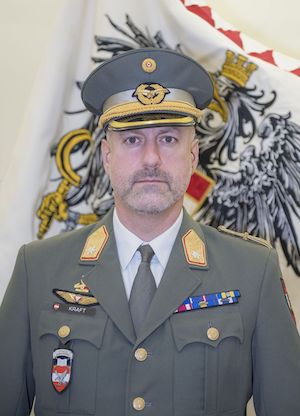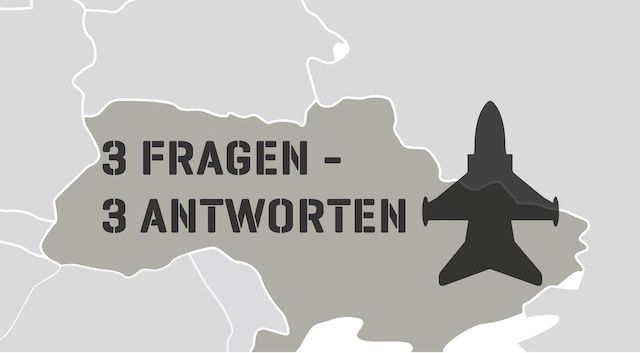Get the weekly SPARTANAT newsletter.
Your bonus: the free E-Book from SPARTANAT.

Brigadier Reinhard Kraft is the commander of the Air Force and Air Defense Troop School of the Federal Army. He explains the tasks that air forces have and why they play an important role in conflicts like the war in Ukraine.

Statement from the Federal Army Expert:
What can be understood by "air forces"? Are these just the planes and helicopters flying around?
Air forces consist of many parts. The whole system only works if all parts interlock like gears.
To operate a combat aircraft or a helicopter, pilots are needed. Technicians ensure that the aircraft remain operational. Air traffic controllers coordinate traffic in the airspace, and radar personnel guide a fighter jet to a suspicious aircraft in the air.
In addition, data from various radar systems are combined to create an air situation picture. This requires highly qualified software specialists and experienced radar operation service employees. Other technicians take care of all communication systems, radar systems, control centers, and computer systems.
Other tasks involve soldiers from aerial reconnaissance who use highly developed technical systems to take aerial photos and analyze them. Facilities on the ground are protected from threats by the air defense. And should there be problems during a landing, the aircraft rescue, or the military airport fire department, responds.
What tasks do air forces have?
The most important task in a conflict is initially to combat the enemy's air forces. The aim is to achieve air superiority and then expand it to complete air supremacy. Combat aircraft, air defense weapons, communication facilities, radar systems, ammunition depots, aircraft factories, airfields, and command centers are targeted.
Once air superiority is established, the air forces begin to support ground troops. This is done through air attacks ("Close Air Support"), aerial reconnaissance, electronic warfare, or even by air transports to quickly move troops to a new location.
Additional tasks include airstrikes deep in the operational area, for which combat aircraft with corresponding stealth characteristics or long-range weapon systems are needed. Another important area of focus is the defense against missiles and cruise missiles.
It should be noted that not everything that flies necessarily belongs to the air forces: Many ground forces have their own transport and combat helicopters, and they often use reconnaissance drones, grenade launchers, or artillery weapons whose projectiles reach far into the air with their trajectory. All this air traffic must be coordinated by air force experts.
The call from Ukraine to close the airspace and supply additional air defense missiles or combat aircraft shows how important air forces are. They cannot win wars alone, but with their many capabilities, they are indispensable in modern warfare.
Have the Russians already achieved air superiority or air supremacy in Ukraine?
Air superiority means being able to conduct military operations without significant restrictions for a certain period of time and/or in a certain area. Only when actual air supremacy is achieved can operations be conducted unhindered anytime and anywhere.
Until now, Russia has not been able to achieve its presumed goal of gaining air supremacy over Ukraine. However, they have established air superiority in large parts of the country. This means that Russia can conduct air operations. However, the risk during missions is higher, and airstrikes cannot be carried out unchecked.
Ukraine is still able to put up serious resistance with combat aircraft and air defense, as evidenced by the shootings down of Russian combat aircraft and helicopters. Therefore, Russia is using long-range standoff weapons, such as the hypersonic weapon "Kinzhal," to reduce the risk to its own aircraft.
BUNDESHEER online
UKRAINE: 3 Questions – 3 Answers
– UKRAINE: 3 QUESTIONS – 3 ANSWERS, PART 15: BATTLE OF THE COMBINED WEAPONS?
– UKRAINE: 3 QUESTIONS – 3 ANSWERS, PART 14: TANK BATTLE?
– UKRAINE: 3 QUESTIONS – 3 ANSWERS, PART 13: BATTLE UNDERGROUND?
– UKRAINE: 3 QUESTIONS – 3 ANSWERS, PART 12: CYBERWAR?
– UKRAINE: 3 QUESTIONS – 3 ANSWERS, PART 11: NEUTRALITY?
– UKRAINE: 3 QUESTIONS – 3 ANSWERS, PART 10: HOW'S IT GOING?
– UKRAINE: 3 QUESTIONS – 3 ANSWERS, PART 9: NBC RISK?
– UKRAINE: 3 QUESTIONS – 3 ANSWERS, PART 8: BATTLE FOR THE CITIES
– UKRAINE: 3 QUESTIONS – 3 ANSWERS, PART 7: AIR WAR AND DRONES
– UKRAINE: 3 QUESTIONS – 3 ANSWERS, PART 6: NUCLEAR POWER PLANTS AND NUCLEAR THREAT
– UKRAINE: 3 QUESTIONS – 3 ANSWERS, PART 5: WHICH WEAPONS?
– UKRAINE: 3 QUESTIONS – 3 ANSWERS, PART 4: WEAPONS FOR KIEV?
– UKRAINE: 3 QUESTIONS – 3 ANSWERS, PART 3: IS THERE RESISTANCE?
– UKRAINE: 3 QUESTIONS - 3 ANSWERS, PART 2: WHAT ARE THE CONSEQUENCES OF THE ATTACK?
– UKRAINE: 3 QUESTIONS - 3 ANSWERS, PART 1: WHAT IS HAPPENING?
SPARTANAT is the online magazine for Military News, Tactical Life, Gear & Reviews.
Send us your news: [email protected]
Ad
similar
Get the weekly SPARTANAT newsletter.
Your bonus: the free E-Book from SPARTANAT.


